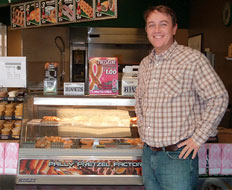Cheesesteaks aren’t the only food Philadelphia obsesses over. Brent Schadler of Philly Pretzel Factory has been serving pretzels to a loyal community in the City of Brotherly Love since 2008.
Schadler developed a grassroots-style marketing strategy at both of his Philly Pretzel units. He’s not only immersing himself in the community, but also using fundraising as a main source of marketing for his business. While contributing to national organizations like the Red Cross and the Susan G. Komen Foundation, Schadler also delivers business to his units and creates relationships with local schools and churches.
Schadler shares how franchisees can use fundraising and community involvement to build consistent and dedicated business at their stores.
1. Look at Fundraising as You Would Marketing
It’s a fundamental element in quick service: Develop a quality product and provide the best customer service. Fundraising is another avenue of business where we get to practice both of those basic components of business out in the community and not just in our stores. Franchisees spend a lot of time and money building on these parts of business, and fundraising can only help these ventures.
Marketing costs a lot of money. A radio spot or phonebook ad can add up after a while and not guarantee anything in return. With fundraising, our product is out there, as well as our name, making it easier to reach a potential customer base we might be missing.
Simply put: It’s our biggest marketing campaign. This is especially good for franchisees similar to a brand like mine, because it’s hard to compete with the big brands out there. It really has the potential to give you an edge against huge marketing campaigns.
It’s really a no-brainer if a franchisee is undecided. The impact on our business is extraordinary. Being an on-site owner, I see people come in and recognize my brand, my staff, and my product. We might have reached out to kids for a community or school event and the kids tell their parents and so on. It’s a level of brand awareness that goes a long way.
2. Take Control of Your Fundraising Partnerships
The best part about a business avenue like this is the option to develop it yourself. If you’re at this point in your business, looking to stretch your legs a bit, you more than likely have customers who already have first-hand experience with your product, which is immediately to your advantage.
When you move forward, go out there yourself. Talk to these businesses or schools and speak with them directly. Go to athletic associations. Be honest with them. Both parties should immediately feel honored with the potential to make money symbiotically. Set up meetings and bring your product with you. It’s a small expense for the possibility of future business.
Next, decide and develop. Are there minimum or maximum amounts for a particular program? How much of each dollar would go toward that organization, or would a total percentage of daily sales be better? You might have some hiccups at the start, but this is your tool.
You can overcome any obstacle in terms of costs or options. I’ve never had to turn down an opportunity to give. Our product and service is there but again, we might not have that same type of influence as a big-brand quick serve. As a result, we are able to get deeper in the terms of opportunities and community involvement.
3. Remember That You Still Have to Come Out on Top
This really is a great tool for business, but it has the ability to ruin a business fast. You might be focusing too much on your wholesale costs for fundraising stints and miss serving the retail at a profitable cost.
Even worse, you didn’t set up a profit margin correctly and too many pennies on the dollar are going toward the organization that your net gain is very little based on your cost.
Bluntly put, if you don’t trust your product and your staff to perform, this can be a hurtful undertaking. It’s not pure selflessness. You need to come out on top somehow.
The other element in the puzzle is having a staff capable of handling this type of business. Your employees need to be on site and operate business just like you.
If a customer calls in and wants a large order for an athletic event, my staff takes the reins, and knows what questions to ask. They are professional and apt to provide the customer with the right options without wasting our product or their money.
4. Evolve the Idea and Trust Your Customer
In what seems like no time at all, you’ll have done a lot of fundraising or product sales for organizations. Try to mix it up a little if it seems stagnant. If you have organizations that might not be directly involved with the community, reach out to them. Get additional information and legitimize it for their group.
Just because it’s a fundraiser for a school athletic program doesn’t mean you don’t need to know the market you’re catering toward; there’s potential everywhere. With community involvement comes loyal patrons, and this usually presents a possible trust issue with customers. You’ll get to know most of your faithful customers and might let them do some unconventional things in terms of payment or job order.
When it comes to organizations that may seem a little shaky, talk to them more about what they want and work something out. Find out what sort of options you can do for their job. It all comes back to developing a fundraising option that works on both levels, business and customer, even if it changes from time to time.












